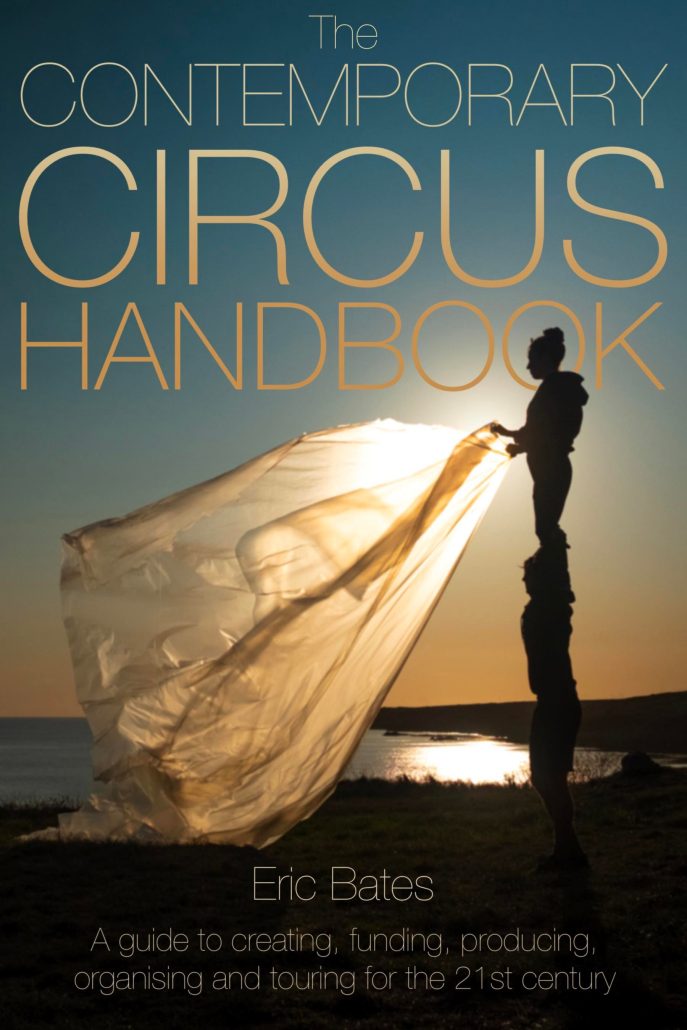Back to the Contemporary Circus Handbook landing page.
Foreword
I’ve worked with Eric for over 14 years now. He has been my employee, my collaborator, and my friend. As a performer and technician, his talent and excellence are unmatched. I am not surprised by the care and thoroughness with which he has approached The Contemporary Circus Handbook. I am not even surprised by his writing chops! But I am a little surprised that, with everything he could be doing with his talent and his time, he chose to put all this down on paper for us, uniting our community in this unprecedented way.
When Eric first told me he was writing a how-to book for circus show and company creating, I didn’t love the idea. The thought that my profession—and decades of painful learning—was going to be reduced to a “just add hot water and serve”/ Circus Directing for the Complete Klutz-type handbook kind of terrified me. But the more we spoke, and the more I heard the angle of his interview questions, saw the roster of interviewees, noticed the humility and curiosity with which he approached the subject matter—the more I realized it was completely the opposite. He wasn’t simplifying a complex process. He was sharing and revealing its complexities. He was attempting to unravel this untouched messy ball of knots that was the “wing it and cross your fingers” circus culture—unravel it and weave it into a cohesive tapestry. The challenges, the lessons, the wisdom and even the stupidities; all generously shared so we can collectively gaze and learn.
Circus is shockingly lawless. We pride ourselves on making our own rules, on functioning off gut and sweat and instinct. We pride ourselves on having our own private methods and rituals, on not following any standardized forms. There is immense beauty in this, but the downside of course is that we are lacking scribes and collective memory; we are often letting the hard-earned lessons disappear with our predecessors. It’s hard to evolve at this level—to learn off each other’s backs—if we don’t have a way of disseminating that knowledge.
Let’s face it: circus people don’t do circus because it will make them rich and famous, because they randomly chose a major in college, because they want to win a gold medal, because they want their parents’ approval, because they want job security or a good pension, because it’s the wave of the future—and definitely not because it’s the easy way out. It’s hard to think of a metier that is more passion-fueled. How crazy-passionate do you have to be, to endure the physical pain, the injuries, the shaky job security, and to literally risk your life daily for so little reward? Except the deeper, more visceral, more soulful kind. Except the bond you forge with your comrades. Except the lives you change, lift and inspire in those seats.
I realized there was something similar with Eric’s desire to write this book, something so true to that circus essence. It is passion-fueled, sincere, generous; building bridges between circumscribed companies and philosophies.
This book is meticulously researched and constructed. Founding a company is not the ‘easy way’, writing this book was not the ‘easy way’. Clearly a labor of love, one from which we will all benefit greatly, from what he has generously compiled for us, the readers.
And not only circus readers… A number of this book’s lessons go beyond the circus industry. They speak of how to collaborate creatively in a broader sense. From the largest corporations to the tiniest family home, we all struggle with properly collaborating, listening, exchanging. I’d like to say this is the key to “success”—but more importantly—it’s the key to humanity. If we better understand the tools of collaboration, we better create a compassionate society.
In the past, circus has had a primarily oral tradition, leading to a lack of writing, research, or simple documentation on the topic. Our legitimacy suffers for this. Quite often circus academics are not those practicing in the field. Although there are serious studies and publications, these documents are rarely coupled with hands-on, real-life proof of concept. This book is an enormous step in the direction of publishing the particulars of our art form and process for posterity.
Is this book going to change the world one circus company at a time? Possibly. But perhaps more importantly, it will help soften all the hard stuff, clarify all the confusing stuff, lighten all the heavy stuff so we can focus on the business of forging bonds and changing lives. Which will in turn absolutely change the world one circus company at a time.
Shana Carroll
Founder, the Seven Fingers
Montréal, Canada, 2024
(Updated copies available immediately.)
(Updated copies might not be available on Amazon until Fall ’24)


